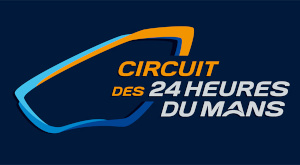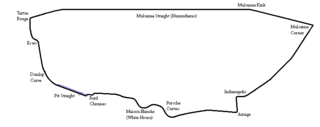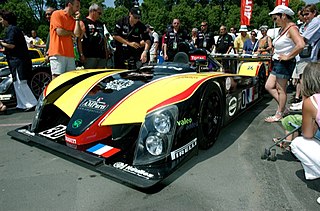Related Research Articles

The V6 PRV engine is an automobile petrol V6 engine that was developed jointly by Peugeot, Renault and Volvo Cars – and sold from 1974 to 1998. It was gradually replaced after 1994 by another joint PSA-Renault design, known as the ES engine at PSA and the L engine at Renault. It was designed and manufactured by the company "Française de Mécanique" for PSA, Renault and Volvo.
The Ferrari P was a series of Italian sports prototype racing cars produced by Ferrari during the 1960s and early 1970s.

The Circuit des 24 Heures du Mans, also known as Circuit de la Sarthe located in Le Mans, Sarthe, France, is a semi-permanent motorsport race course, chiefly known as the venue for the 24 Hours of Le Mans auto race. Comprising private, race-specific sections of track in addition to public roads which remain accessible most of the year, its present configuration is 13.626 km (8.467 mi) long, making it one of the longest circuits in the world. The capacity of the race stadium, where the short Bugatti Circuit is situated, is 100,000. The Musée des 24 Heures du Mans is a motorsport museum located at the main entrance of the venue.

The Toyota TS010 was a Group C racing car built by Toyota for the Sportscar World Championship, All Japan Sports Prototype Championship, and the 24 Hours of Le Mans.

The 1988 24 Hours of Le Mans was the 56th Grand Prix of Endurance, and took place on 11 and 12 June 1988. It was also the fifth round of the World Sports-Prototype Championship season.

The 1982 24 Hours of Le Mans was the 50th Grand Prix of Endurance, which took place on 19 and 20 June 1982. It was also the fourth round of the 1982 World Endurance Championship. As well as a significant anniversary, this was a watershed year for Le Mans, with the highly anticipated advent of the FIA's Group C regulations, the essence of which was to allow an open engine formula but a minimum weight for safety and a proscribed fuel allocation.

The 1981 24 Hours of Le Mans was the 49th Grand Prix of Endurance, and took place on 13 and 14 June 1981. It was also the eighth round of the World Endurance Championship of Drivers, and the fifth round of the World Championship for Makes.

The 1980 24 Hours of Le Mans was the 48th Grand Prix of Endurance, and took place on 14 and 15 June 1980. It was the seventh round of both the World Championship for Makes and World Challenge for Endurance Drivers. With neither the Porsche nor Renault works teams contesting the big Group 6 sports-cars for outright victory, it left the prospects open for a privateer victory from Joest, Rondeau or De Cadenet, or from Group 5 again, if they were to fail. The wet weather throughout the race further added to the uncertainty, reducing the advantage of the more powerful cars.

The 1978 24 Hours of Le Mans was the 46th Grand Prix of Endurance, and took place on 10 and 11 June 1978. In many ways it was a continuation of the race from the year before – the two main protagonists would be the very evenly-matched works teams of Alpine-Renault and Porsche, with four cars each. The race was not valid for any championship.

The 1976 24 Hours of Le Mans was the 44th Grand Prix of Endurance, and took place on 12 and 13 June 1976. This year the FIA introduced its new Group 5 and Group 6 regulations and the race was now open to nine distinct classes, although it was still not part of the World Championship seasons. Porsche introduced its new models, the 936 in Group 6, the 935 in Group 5 and the 934 in Group 4. In response, BMW had its modified 3.0 CSL in Group 5. It was the year that turbos arrived in considerable numbers, with over a dozen turbocharged entries, led by the Renault Alpine A442. It saw the arrival of French prototype manufacturers Jean Rondeau and Gérard Welter in a new GTP class and a first-time invitation to American IMSA and NASCAR entries.

Welter Racing is a French sports car maker that mainly enters in the 24 Hours of Le Mans, since 1990 under the name of Rachel and Gérard Welter, Peugeot's late head of design or Rachel Welter.

The Sauber SHS C6 was a Group C prototype racing car built by Swiss manufacturer Sauber and engineering firm Seger & Hoffman, intended for competition in the World Endurance Championship and Deutsche Rennsport Meisterschaft series. Seger & Hoffman left the project later in 1982, leaving the car completely under Sauber's control.

The Mulsanne Straight is the name used in English for a formerly 6 km (3.7 mi) long straight of the Circuit de la Sarthe around which the 24 Hours of Le Mans auto race takes place. Since 1990, the straight is interrupted by two chicanes, with the last section leading to a sharp corner near the village of Mulsanne.

The Rondeau M382 was a Group C prototype sports car, designed, developed and built by Automobiles Jean Rondeau in 1981, and used in sports car racing between 1982 and 1986.

The Ligier JS2 is a mid-engined sports coupé that was built by Ligier in the French commune of Abrest near Vichy in the department of Allier between 1971 and 1975. Road-going and competition versions were built.

The Welter-Meunier P80 is a sports prototype race car, designed, developed and built by French racing team Welter Racing, for sports car racing, specifically the 24 Hours of Le Mans, between 1980 and 1982. It was powered by a twin-turbocharged 2.7 L (160 cu in) Peugeot PRV V6 engine, producing 500 hp (370 kW), which drove the rear wheels through a 5-speed ZF manual transmission. The bodywork is constructed out of Kevlar epoxy and carbon fiber.
The Welter-Meunier P87 was a Group C sports prototype race car, designed, developed, and built by French motorsports team Welter Racing in 1987 and used in sports car racing until 1988. Only one model was produced.
The WM P76 was a sports prototype race car, designed, developed, built and used by French racing team Welter Racing in the 1976–1978 Le Mans 24 Hours.

The Welter-Meunier P88 is a Group C sports prototype race car, designed, developed, and built by the French racing team Welter Racing, specifically to compete in the 24 Hours of Le Mans that year. It was designed and constructed according to the FIA's technical and sporting regulations for sports car racing.

The WR LM94, and its evolutions, the WR LM95, and the WR LM96, were a series of prototype sports car, designed, developed, built, and used by Welter Racing in the 1994 and 1995 24 Hours of Le Mans.